Architectonic subdivisions of neocortex in the tree shrew (Tupaia belangeri)
- PMID: 19462403
- PMCID: PMC2866046
- DOI: 10.1002/ar.20916
Architectonic subdivisions of neocortex in the tree shrew (Tupaia belangeri)
Abstract
Tree shrews are small mammals that bear some semblance to squirrels, but are actually close relatives of primates. Thus, they have been extensively studied as a model for the early stages of primate evolution. In this study, subdivisions of cortex were reconstructed from brain sections cut in the coronal, sagittal, or horizontal planes, and processed for parvalbumin, SMI-32-immunopositive neurofilament protein epitopes, vesicle glutamate transporter 2 (VGluT2), free ionic zinc, myelin, cytochrome oxidase, and Nissl substance. These different procedures revealed similar boundaries between areas, suggesting the detection of functionally relevant borders and allowed a more precise demarcation of cortical areal boundaries. Primary cortical areas were most clearly revealed by the zinc stain, because of the poor staining of layer 4, as thalamocortical terminations lack free ionic zinc. Area 17 (V1) was especially prominent, as the broad layer 4 was nearly free of zinc stain. However, this feature was less pronounced in primary auditory and somatosensory cortex. In primary sensory areas, thalamocortical terminations in layer 4 densely express VGluT2. Auditory cortex consists of two architectonically distinct subdivisions, a primary core region (Ac), surrounded by a belt region (Ab) that had a slightly less developed koniocellular appearance. Primary motor cortex (M1) was identified by the absence of VGluT2 staining in the poorly developed granular layer 4 and the presence of SMI-32-labeled pyramidal cells in layers 3 and 5. The presence of well-differentiated cortical areas in tree shrews indicates their usefulness in studies of cortical organization and function.
Figures


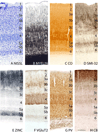


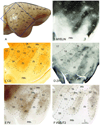
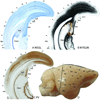

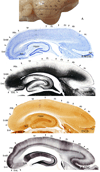
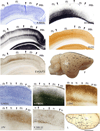

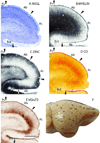
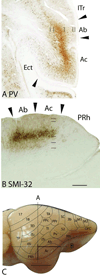



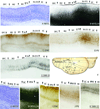




Similar articles
-
Architectonic subdivisions of neocortex in the Galago (Otolemur garnetti).Anat Rec (Hoboken). 2010 Jun;293(6):1033-69. doi: 10.1002/ar.21109. Anat Rec (Hoboken). 2010. PMID: 20201060 Free PMC article.
-
An architectonic study of the neocortex of the short-tailed opossum (Monodelphis domestica).Brain Behav Evol. 2009;73(3):206-28. doi: 10.1159/000225381. Epub 2009 Jun 16. Brain Behav Evol. 2009. PMID: 19546531 Free PMC article.
-
Architectonic subdivisions of neocortex in the gray squirrel (Sciurus carolinensis).Anat Rec (Hoboken). 2008 Oct;291(10):1301-33. doi: 10.1002/ar.20758. Anat Rec (Hoboken). 2008. PMID: 18780299 Free PMC article.
-
VGLUT1 and VGLUT2 mRNA expression in the primate auditory pathway.Hear Res. 2011 Apr;274(1-2):129-41. doi: 10.1016/j.heares.2010.11.001. Epub 2010 Nov 24. Hear Res. 2011. PMID: 21111036 Free PMC article. Review.
-
The evolution of brains from early mammals to humans.Wiley Interdiscip Rev Cogn Sci. 2013 Jan;4(1):33-45. doi: 10.1002/wcs.1206. Epub 2012 Nov 8. Wiley Interdiscip Rev Cogn Sci. 2013. PMID: 23529256 Free PMC article. Review.
Cited by
-
Spatiotemporal Profile of Voltage-Sensitive Dye Responses in the Visual Cortex of Tree Shrews Evoked by Electric Microstimulation of the Dorsal Lateral Geniculate and Pulvinar Nuclei.J Neurosci. 2015 Aug 26;35(34):11891-6. doi: 10.1523/JNEUROSCI.0717-15.2015. J Neurosci. 2015. PMID: 26311771 Free PMC article.
-
c-FOS expression in the visual system of tree shrews after monocular inactivation.J Comp Neurol. 2017 Jan 1;525(1):151-165. doi: 10.1002/cne.24053. Epub 2016 Jun 19. J Comp Neurol. 2017. PMID: 27276555 Free PMC article.
-
Areas of cat auditory cortex as defined by neurofilament proteins expressing SMI-32.Hear Res. 2010 Aug;267(1-2):119-36. doi: 10.1016/j.heares.2010.04.003. Epub 2010 Apr 27. Hear Res. 2010. PMID: 20430082 Free PMC article.
-
Escaping the nocturnal bottleneck, and the evolution of the dorsal and ventral streams of visual processing in primates.Philos Trans R Soc Lond B Biol Sci. 2022 Feb 14;377(1844):20210293. doi: 10.1098/rstb.2021.0293. Epub 2021 Dec 27. Philos Trans R Soc Lond B Biol Sci. 2022. PMID: 34957843 Free PMC article.
-
Cell-poor septa separate representations of digits in the ventroposterior nucleus of the thalamus in monkeys and prosimian galagos.J Comp Neurol. 2011 Mar 1;519(4):738-58. doi: 10.1002/cne.22545. J Comp Neurol. 2011. PMID: 21246552 Free PMC article.
References
-
- Abplanalp P. Some subcortical connections of the visual system in tree shrews and squirrels. Brain Behav Evol. 1970;3(1):155–168. - PubMed
-
- Allman JM, Kaas JH. Representation of the visual field in striate and adjoining cortex of the owl monkey (aotus trivirgatus) Brain Res. 1971;35(1):89–106. - PubMed
-
- Augustine JR. The insular lobe in primates including humans. Neurol Res. 1985;7(1):2–10. - PubMed
-
- Barbas H, Pandya DN. Architecture and frontal cortical connections of the premotor cortex (area 6) in the rhesus monkey. J Comp Neurol. 1987;256(2):211–228. - PubMed
-
- Bishop A. Use of the hand in lower primates. In: Buettner-Janusch J, editor. Evolutionary and genetic biology of primates. New York: Academic Press; 1964. pp. 133–225.
Publication types
MeSH terms
Substances
Grants and funding
LinkOut - more resources
Full Text Sources

